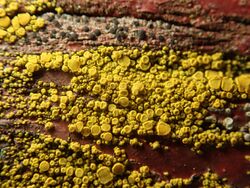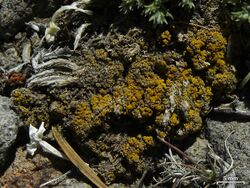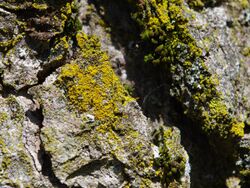Biology:Candelariella
| Candelariella | |
|---|---|

| |
| Candelariella vitellina | |
| Scientific classification | |
| Domain: | Eukaryota |
| Kingdom: | Fungi |
| Division: | Ascomycota |
| Class: | Candelariomycetes |
| Order: | Candelariales |
| Family: | Candelariaceae |
| Genus: | Candelariella Müll.Arg. (1894) |
| Type species | |
| Candelariella vitellina (Ehrh.) Müll.Arg. (1894)
| |
| Species | |
|
See text | |
Candelariella is a genus of bright yellow, ocher, or greenish yellow crustose or squamulose lichens in the family Candelariaceae.[1] Members of the genus are commonly called eggyolk lichens,[2] goldspeck lichens, or yolk lichens.[3] The genus was circumscribed in 1894 by Swiss lichenologist Johannes Müller Argoviensis, with Candelariella vitellina assigned as the type species.[4]
Characteristics
The key feature of Candelariella species are the distinct yellow apothecia.[3] Although all species are very small, even the smallest can be identified by the lemon-yellow to orange-yellow discs. Most species have a yellow thallus, although Candelariella antennaria is one example with a grey thallus. Some species are pycnidiate. This genus will generally have all spot tests emerge as negative, although K tests may have an orange or reddish colour on some species' apothecia.[5]
Spore count between species varies from 8 to 32 simply or thinly septate spores. Spores often hold one to two oil drops.[5]
Habitat and distribution
Candelariella species are found across the globe, although most commonly described in North America, Asia, and Australia. Species can be found on calcareous and non-calcareous rock, soil, tree bark, mosses, and other lichens. While some species may grow only on rock, and others only on trees, the more generalist species can be found in a variety of locations.[5]
Ecology
As of 2016, 16 lichenicolous fungi have been documented parasitising species of the genus Candellariella. These are: Tremella candelariellae, Polysporina subfuscescens, Sarcogyne sphaeospora, Arthonia almquistii, Caloplaca grimmiae, Carbonea vitellinaria, Trichonectria furcatosetosa, Lichenochora arctica, Sarcopyrenia cylindrospora, Zwackhiomyces lecanorae, Phoma candelariellae, Henfellra muriformis, Ascochyta candelariellicola, Taeniolella delicata, Intralichen christiansenii, and Intralichen lichenicola.[6]
Species
- Candelariella aggregata M.Westb. (2007)[7]
- Candelariella antennaria Räsänen (1939)[8]
- Candelariella arctica (Körb.) R.Sant. (1966)
- Candelariella aurella (Hoffm.) Zahlbr. (1928)
- Candelariella australiensis P.M.McCarthy & Elix (2017)[9] – Australia
- Candelariella biatorina M.Westb. (2007)[10]
- Candelariella blastidiata Yakovch. (2017)[11]
- Candelariella boikoi Khodos. & S.Y.Kondr. (2004)[12]
- Candelariella boleana Etayo, Palice & T.Sprib. (2009)[13] – Europe
- Candelariella borealis M.Westb. (2007)[14] – North America
- Candelariella californica M.Westb. (2007)[7]
- Candelariella clarkiae E.Tripp & Lendemer (2015)[15]
- Candelariella commutata Otte & M.Westb. (2013)[16]
- Candelariella complanata M.Westb. (2007)[7]
- Candelariella coralliza (Nyl.) H.Magn. (1935)
- Candelariella corallizoides M.Westb. (2007)[7]
- Candelariella corviniscalensis C.A.Morse & M.Westb. (2011)[17]
- Candelariella deppeanae M.Westb. (2007)[7]
- Candelariella efflorescens R.C.Harris & W.R.Buck (1978)[18]
- Candelariella flavosorediata Kalb & Aptroot (2021)[19] – Réunion
- Candelariella flavovirella (Nyl.) Lettau (1912)
- Candelariella granuliformis M.Westb. (2011)[17]
- Candelariella hakulinenii S.Y.Kondr., Lőkös & Hur (2017)[20]
- Candelariella immarginata M.Westb. (2007)[7]
- Candelariella lichenicola M.Westb. (2007)[10]
- Candelariella makarevichiae S.Y.Kondr., Lőkös & Hur (2018)[21]
- Candelariella medians (Nyl.) A.L.Sm. (1918)
- Candelariella reflexa (Nyl.) Lettau (1912)
- Candelariella rosulans (Müll.Arg.) Zahlbr. (1928)
- Candelariella rubrisoli D.Liu & Hur (2019)[22]
- Candelariella superdistans (Nyl.) Malme (1911)
- Candelariella vainioana Hakul. (1954)
- Candelariella vitellina (Hoffm.) Müll.Arg. (1894)
- Candelariella xanthostigma (Pers. ex Ach.) Lettau (1912)
- Candelariella xanthostigmoides (Müll.Arg.) R.W.Rogers (1982)
References
- ↑ Wijayawardene, Nalin; Hyde, Kevin; Al-Ani, Laith Khalil Tawfeeq; Somayeh, Dolatabadi; Stadler, Marc; Haelewaters, Danny et al. (2020). "Outline of Fungi and fungus-like taxa". Mycosphere 11: 1060–1456. doi:10.5943/mycosphere/11/1/8.
- ↑ Name Search Results for Scientific Name Candelariella, USDA
- ↑ 3.0 3.1 Sharnoff, S. (2014). Field Guide to California Lichens. Yale University Press. p. 249. ISBN 978-0-300-19500-2.
- ↑ Müller, J. (1894). "Conspectus systematicus lichenum Novae Zelandiae" (in la). Bulletin de l'Herbier Boissier 2 (App. 1): 11, 47.
- ↑ 5.0 5.1 5.2 Westberg, M.; Nash, T.H. (2002). "Candelariella". Lichen Flora of the Greater Sonoran Desert Region. 2. ISBN 978-0-9716759-0-2.
- ↑ Hawksworth, David L.; Halıcı, Mehmet Gökhan; Kocakaya, Zekiye; Kocakaya, Mustafa (2016). "Henfellra muriformis gen. et sp. nov., a new dictyosporous pycnidial fungus on Candelariella, with a key to the lichenicolous fungi known from that genus". Herzogia 29 (2): 329–336. https://www.researchgate.net/publication/312430701.
- ↑ 7.0 7.1 7.2 7.3 7.4 7.5 Westberg, Martin (2007). "Candelariella (Candelariaceae) in western United States and northern Mexico: the 8-spored, lecanorine species". The Bryologist 110 (3): 391–419. doi:10.1639/0007-2745(2007)110[391:cciwus2.0.co;2].
- ↑ Räsänen, V. (1939). "II. Contribucion a la flora liquenologica sudamericana". Anales de la Sociedad Científica Argentina 128: 133–147.
- ↑ McCarthy, P.M.; Elix, J.A. (2017). "A new species and new record of Candelariella (lichenized Ascomycota, Candelariaceae) from Australia". Australasian Lichenology 81: 79–85.
- ↑ 10.0 10.1 Westberg, Martin (2007). "Candelariella (Candelariaceae) in western United States and northern Mexico: the species with biatorine apothecia". The Bryologist 110 (3): 365–374. doi:10.1639/0007-2745(2007)110[365:cciwus2.0.co;2].
- ↑ Yakovchenko, Lidia S.; Vondrák, Jan; Ohmura, Yoshihito; Korchikov, Evgeny S.; Vondrákova, Olga S.; Davydov, Evgeny A. (2017). "Candelariella blastidiata sp. nov. (Ascomycota, Candelariaceae) from Eurasia and North America, and a key for grey thalli Candelariella". The Lichenologist 49 (2): 117–126. doi:10.1017/s0024282917000020.
- ↑ Khodosovtsev, A.; Kondratyuk, S.Y.; Kärnefelt, I. (2004). "Candelariella boikoi, a new lichen species from Eurasia". Graphis Scripta 16: 11–15.
- ↑ Etayo, J.; Palice, Z.; Spribille, T. (2009). "Candelariella boleana, a new epiphytic species from southern and central Europe (Candelariaceae, Ascomycota)". Nova Hedwigia 89 (3–4): 545–552.
- ↑ Westberg, Martin (2007). "Candelariella (Candelariaceae) in western United States and northern Mexico: the polysporous species". The Bryologist 110 (3): 375–390. doi:10.1639/0007-2745(2007)110[375:cciwus2.0.co;2].
- ↑ Tripp, Erin A.; Lendemer, James C. (2015). "Erratum:Candelariella clarkii corrected to Candelariella clarkiae". The Bryologist 118 (2): 240. doi:10.1639/bryo-118-02-240-240.1.
- ↑ Otte, V.; Yakovchenko, L.; Clerc, Ph.; Westberg, M. (2013). "Candelariella commutata sp. nov. for C. unilocularis auct. medioeur. – an arctic-alpine lichen on calcareous substrata from the Caucasus and Europe". Herzogia 26: 217–222.
- ↑ 17.0 17.1 Westberg, Martin; Morse, Caleb A.; Wedin, Mats (2011). "Two new species of Candelariella and a key to the Candelariales (lichenized Ascomycetes) in North America". The Bryologist 114 (2): 325–334. doi:10.1639/0007-2745-114.2.325.
- ↑ Harris, R.C.; Buck, W.R. (1978). "Lichens of the Mackinac Straits Region. II. Candelariella Mull. Arg.". The Michigan Botanist 17: 155–161.
- ↑ Kalb, Klaus; Aptroot, André (2021). "New lichens from Africa". Archive for Lichenology 28: 1–12. http://www.fschumm.de/Archive/Vol%2028_Kalb_new%20records%20Africa.pdf.
- ↑ Kondratyuk, S.Y.; Lőkös, L.; Halda, J.P.; Roux, C.; Upreti, D.K.; Schumm, F.; Mishra, G.K.; Nayaka, S. et al. (2017). "New and noteworthy lichen-forming and lichenicolous fungi 6". Acta Botanica Hungarica 59 (1–2): 137–260. doi:10.1556/034.59.2017.1-2.7.
- ↑ Kondratyuk, S.Y.; Lőkös, L.; Halda, J.P.; Farkas, E.; Upreti, D.K.; Thell, A.; Woo, J.-J.; Oh, S.-O. et al. (2018). "New and noteworthy lichen-forming and lichenicolous fungi 7". Acta Botanica Hungarica 60 (1-2): 115–184. doi:10.1556/034.60.2018.1-2.8.
- ↑ Liu, Dong; Wang, Lisong; Wang, Xin Yu; Hur, Jae-Seoun (2019). "Two new species of the genus Candelariella from China and Korea". Mycobiology 47 (1): 40–49. doi:10.1080/12298093.2019.1583785.
Wikidata ☰ Q5031656 entry



